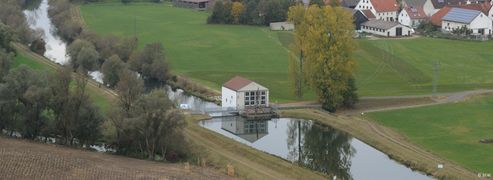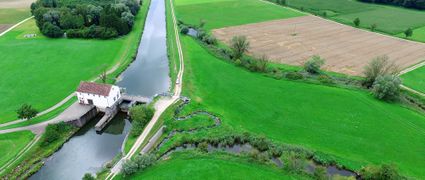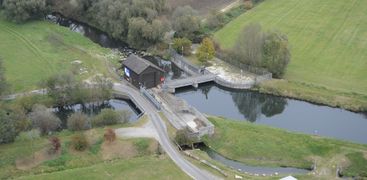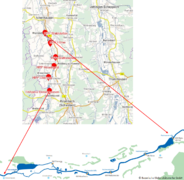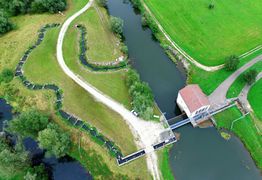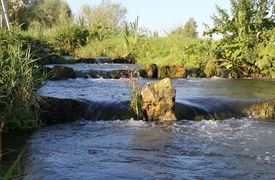Günz test case
| Fact box: Günz | |
|---|---|
| Country | Germany |
| River | Günz |
| Operator | LEW |
| Capacity | 350 - 1100 kW |
| Head | 5 m |
| Inter-annual discharge | 7.8 m3/s |
| Turbine(s) | 1 Kaplan turbine at every HPP |
| Detailed report | Click for pdf |
Contents
Introduction
The river Günz is located in the southern part of Bavaria, Germany. It is about 55 km long and flows into the river Danube near the city Günzburg. The catchment area of the river Günz is 710 km2. The Günz is fed by the confluence of the “Eastern Günz” and the “Western Günz” near the small city Lauben. The Test Case consists of a row of 5 hydropower plants, which are located on the Günz.
The hydrology of the Günz is characterized by flood peaks in winter due to snow melting and some flood peaks in the summer after heavy rain events. The catchment area of the river Günz is 710 km2 The mean interannual discharge of the river Günz is estimated at 7.8 m3/s. The river is classified with a moderate ecological status.
About the hydropower plants
The Test Case Günz comprises 5 consecutive hydropower plants. Four of them are run-of-river hydropower plants and one, the HPP Oberegg, has a diverted reach. Each of the 5 HPPs is equipped with one Kaplan-turbine, with installed capacities of 350 kW at Waldstetten, 450 kW at(Höselhurst and Wattenweiler, 600 kW at Ellzee and 1100 kW at Oberegg. The annual output is between 1.8 – 3.7 millions kWh . The height drop ranges from 3.9 to 8.3 m at the different HPPs.
Layout
The HPPs Höselhurst, Wattenweiler, Ellzee and Waldstetten are run-of-river HPPs, the HPP Oberegg is a diversion hydropower plant (Ausleitungskraftwerk). In the upstream areas of the HPPs there are reservoirs. In the downstream areas the river Günz is still free flowing until the head of the next reservoir. There is a fish bypass channel at every HPP. At the run-of river HPPs they are built as a classical conventional pond system. At Oberegg the fish passage facility for upstream fish migration is integrated into the diverted reach, which is called “Alte Günz”.
The Operator: Bayerische Elektrizitätswerke GmbH (BEW)
The BEW is a 100 % subsidiary of the Lechwerke AG. It runs and maintains 36 HPPs at the rivers Danube, Günz, Lech and Iller and is thereby one of the leading HPP operators in Bavaria, Germany. The company produces over 1 billion kWh energy out of regenerative hydropower per year. Read more.
Pressures on the water body's ecosystem
The main pressures on the water body are hydrology, agricultural use of pesticides, effluents from a nearby water treatment plant, and to some extent the spill over from storm water overflow. Previously, continuity was classified as a high pressure, but this was counteracted through the building of fishways in 2014. The pressures are mainly caused of morphological issues which are results of the HPP. There is a lack of important habitats like juvenile habitats, spawning habitats and the reophilic interstitial. The BEW is working on this problems with a restauration program.
Test case topics
Fish population
The river is dominated by reophilic fish species. The main species are white fish species like nase (Chondrostoma nasus), barbel (Barbus barbus), roach (Rutilus rutilus) and chub (Squalius cevalus). Furthermore, there are many small fish species like bleak (Alburnus alburnus), Bitterling (Rhodeus amarus) and gudgeon (Gobio gobio). Due to the anthropogenic river changes there are also many stagnopil species like pike (Esox lucius) and tench (Tinca tinca).
Upstream migration
There is a fish bypass channel for upstream migration at every HPP. The bypass channel at HPP Deisenhausen has a flow of 500 l/s and is 500 m long. All other fish bypass channels have a flow of 300 l/s and a length of 130 – 180 m. All fish bypass channels are built as a nature like pond system. The first 10 m of every fish bypass channel is built as a technical vertical slot pass to ensure a more or less consistent water flow. In every fish bypass channel there is furthermore a fish counting pool to register all (upward) migrating fish. This research study is done by Thomas Lechner (IBF Umwelt).
E-flow
The Test Case HPPs at the Günz are run-of river and diversion HPPs. The mean flow runs over the basin Oberegg, there is no hydropeaking. The old river called “Alte Günz” is used as a flood channel. The e-flow is 500 l/s at all time, which is the natural minimum water flow. This is the e-flow the authorities specified.
Research objectives and tasks
This section of the Günz is strongly morphologic downgraded and channelized. The morphologic improvement of the Günz itself is difficult because of the closeness to the settlements and no available areas. Therefore, compensation habitats especially as spawning habitats and habitat for reophile fish species are being investigated to upgrade the ecology of strongly channelized rivers. Based on the findings, compensation habitats in the fish passes will be build.
Research tasks
The research tasks and field studies conducted at the HPPs on the river Günz are:
- Potential scenario modelling
- Potential test of CIA tools
- Management, monitoring and construction of spawning habitats in fishway
- Numerical simulations of flow and habitat conditions in the fishway
